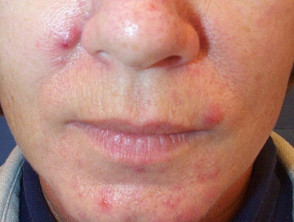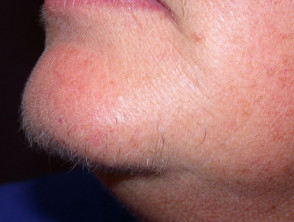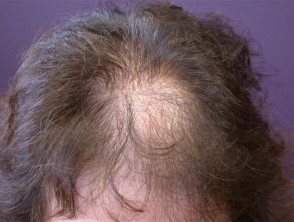Introduction
Polycystic ovary syndrome (PCOS) is characterised by menstrual irregularities/abnormalities, hirsutism (male-like hairiness in women), obesity and metabolic syndrome, resulting from abnormalities in the metabolism of androgens and oestrogen and in the control of androgen production. It was once thought to be mainly due to an ovarian defect as it was often associated with enlarged polycystic ovaries, hence its name polycystic ovary syndrome. However, it is now known that PCOS may occur in women with normal sized ovaries and polycystic ovarian changes can be found in women with normal menstrual cycles.
Who gets it and what is the cause?
PCOS occurs in women only and generally starts at around puberty. It is estimated to affect 3-10% of women. Although the signs and symptoms are similar in most patients, different races can be affected differently. For example, in the US, 70% of patients have hirsutism compared to 10-20% in Japan.
The exact cause of PCOS is not yet known but is thought to develop when the ovaries overproduce androgen hormones (e.g. testosterone). This is caused by the overproduction of luteinizing hormone (LH), which is produced by the pituitary gland. People with PCOS also have an inability to process insulin effectively. This is known as peripheral insulin resistance. It is more of a problem in obese patients. Elevated insulin levels also have an effect on ovarian function.
What are the signs and symptoms?
There are many signs and symptoms associated with PCOS.
- Absent, infrequent or irregular menstrual periods
- Infrequent or absent ovulation causing infertility
- Cystic or enlarged ovaries
- Obesity, occurring in up to 50% of patients who have a high waist to hip ratio (i.e. fat tummy but relatively thin arms and legs)
- Early development of pubic hair (defined as before 8 years in girls and before 9 years in boys)
- Hyperandrogenism (increased serum levels of male hormones) resulting in excess hair growth on the face, chest, abdomen, thumbs or toes (hirsutism); female pattern or sometimes male pattern hair loss; and in severe cases, deepening of voice and increased muscle mass
- Persistent acne and oily skin (seborrhoea)
- Hidradenitis suppurativa (acne inversa), an inflammatory condition that results in boil-like lumps in the armpits, groin and under the breasts
- Acanthosis nigricans: dark patches of skin that are velvety or rough to touch. These occur most commonly on the back of the neck, armpits, area beneath the breasts and exposed areas such as the elbows, knees and knuckles
- Skin tags (acrochordons) in the armpits, under the breasts or in the groin
- Diabetes mellitus, especially likely in obese patients
- High blood pressure (hypertension)
- Elevated blood fats (hyperlipidaemia) with increased triglycerides, total cholesterol and low-density (LDL) cholesterol and low high-density (HDL) cholesterol
- Cardiovascular disease especially coronary artery disease
How is the diagnosis made?
The diagnostic criteria for PCOS include two out of three of:
- Menstrual disturbance
- Clinical or biochemical hyperandrogenism
- Polycystic ovaries on ultrasound scan
If the doctor is suspicious of PCOS, blood tests may be ordered. These may include:
- Hormone tests to measure the amount of free testosterone, LH and other sex hormones
- Fasting glucose or glucose tolerance test, and insulin levels
- Fasting blood fats (lipids)
A pelvic ultrasound examination and/or CT scan or magnetic resonance imaging (MRI) may be useful to detect ovarian or adrenal tmours if levels of testosterone are very high.
Skin signs of polycystic ovaries
What is the treatment of PCOS?
In the past, management of the condition was directed at treating individual symptoms of PCOS, such as hirsutism, acne or fertility. More recently with the understanding that insulin resistance has a large part to play in the development of PCOS, treatment has shifted towards correcting insulin resistance, which in turn improves many other symptoms of the condition.
- Diet and exercise: weight loss in obese PCOS patients leads to decreased insulin resistance and a fall in testosterone levels. Outward improvements include reduced hirsutism and a return of menstrual cycles in some women.
- Metformin and newer glitazone antidiabetic medications decrease insulin resistance and the amount of insulin in the blood. They may also normalise ovulation.
- Stopping smoking reduces the likelihood of smoking-related complications such as blood clots
In addition to the above treatments, specific treatments are used to gain overall control of symptoms.
- Antiandrogenic oral contraceptives (birth control pills) help control acne and hirsutism. They also improve menstrual irregularities. They may be unsuitable for overweight or obese women.
- Spironolactone, a powerful antiandrogen, can reduce acne and also body hair growth over time. It is less effective for alopecia. It cannot be used by women who are trying to conceive as it can cause birth defects.
- Low dose glucocorticoids taken at night are suitable for some women.
- Gonadotrophin releasing hormone agonist medications are under investigation to inhibit pituitary release of LH and thus reduce the secretion of ovarian hormones.
- Isotretinoin is used for severe cases of acne. It cannot be used by women who are pregnant or trying to conceive as it can cause birth defects. PCOS may result in recurrence of acne after initial successful clearance with isotretinoin.
- Hair removal measures such as shaving, electrolysis, chemical and waxing creams can be used to treat hirsutism.


